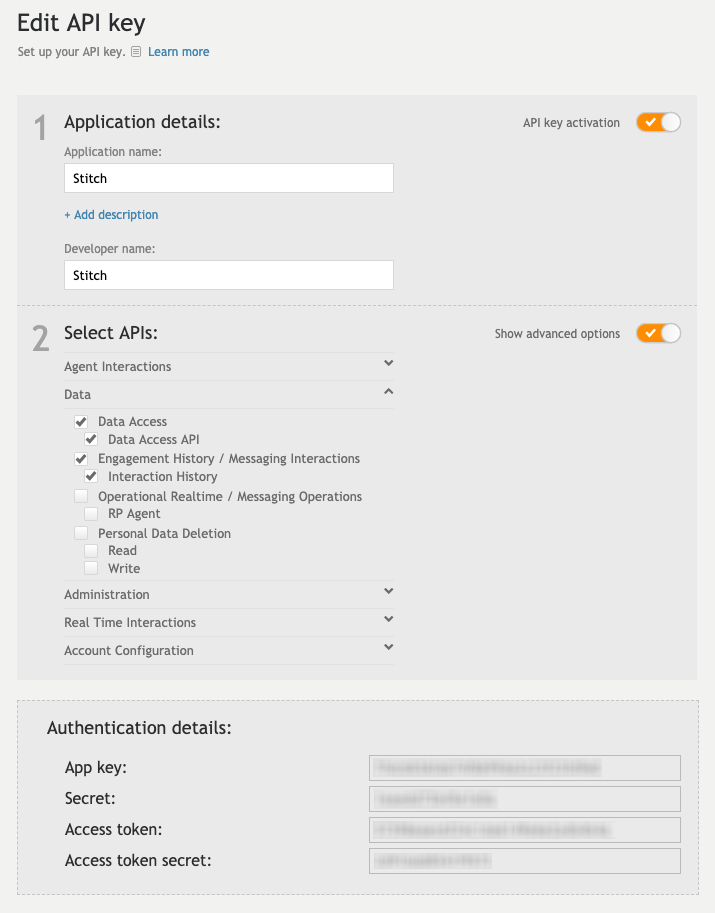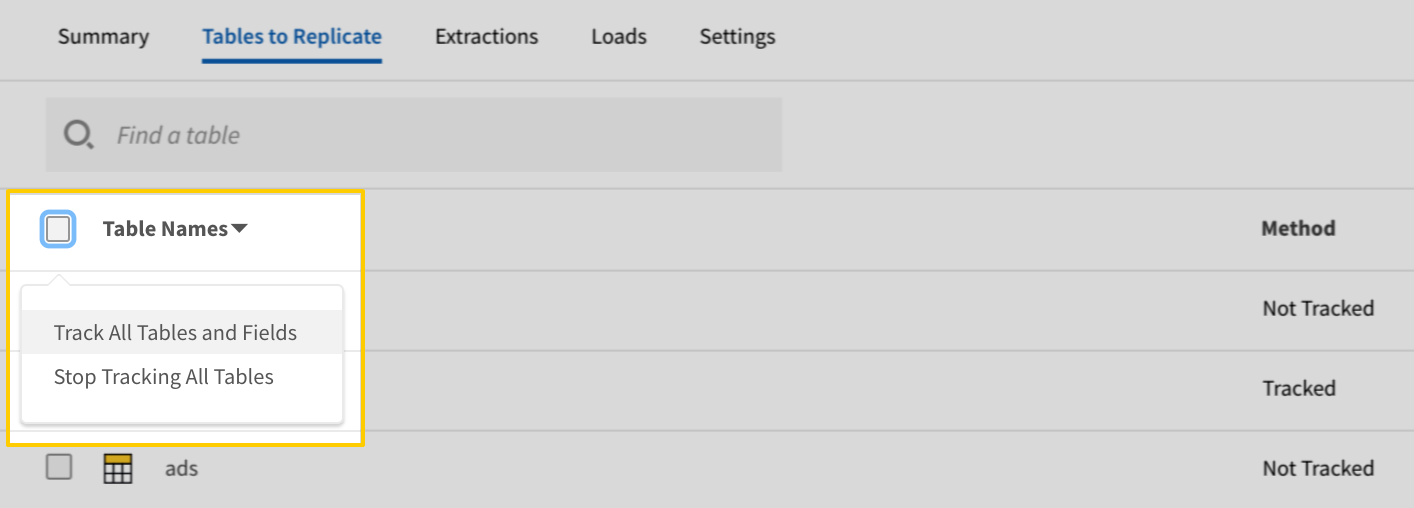This integration is powered by Singer's LivePerson tap. For support, visit the GitHub repo or join the Singer Slack.
LivePerson integration summary
Stitch’s LivePerson integration replicates data using the LivePerson Data Access API. Refer to the Schema section for a list of objects available for replication.
LivePerson feature snapshot
A high-level look at Stitch's LivePerson (v1) integration, including release status, useful links, and the features supported in Stitch.
| STITCH | |||
| Release status |
Released on June 28, 2019 |
Supported by | |
| Stitch plan |
Standard |
API availability |
Available |
| Singer GitHub repository | |||
| REPLICATION SETTINGS | |||
| Anchor Scheduling |
Supported |
Advanced Scheduling |
Supported |
| Table-level reset |
Unsupported |
Configurable Replication Methods |
Unsupported |
| DATA SELECTION | |||
| Table selection |
Supported |
Column selection |
Supported |
| Select all |
Supported |
||
| TRANSPARENCY | |||
| Extraction Logs |
Supported |
Loading Reports |
Supported |
Connecting LivePerson
LivePerson setup requirements
To set up LivePerson in Stitch, you need:
-
The API key administration privilege in LivePerson. This is required to generate API credentials in LivePerson.
Step 1: Generate LivePerson API credentials

- Sign into your LivePerson account.
- Click the Campaigns tab at the top of the page.
- On the Campaigns page, locate and click on the Data Sources link.
- On the Data Sources page, click the API tab.
- Click + Add new.
- In the Application details section, enter
Stitchinto the Application name and Developer name fields. - In the Select APIs section:
- Click the Show advanced options option.
- Open the Data option.
- Click the Data Access option. This should also automatically check the Data Access API option.
- Click the Engagement History / Messaging Interactions option. This should also automatically check the Interaction History option.
- When finished, click the Save button in the lower right corner of the page.
An Authentication details section will display. Leave this page open for now - you’ll need it in the next step.
Step 2: Add LivePerson as a Stitch data source
- Sign into your Stitch account.
-
On the Stitch Dashboard page, click the Add Integration button.
-
Click the LivePerson icon.
-
Enter a name for the integration. This is the name that will display on the Stitch Dashboard for the integration; it’ll also be used to create the schema in your destination.
For example, the name “Stitch LivePerson” would create a schema called
stitch_livepersonin the destination. Note: Schema names cannot be changed after you save the integration. - In the LivePerson App Key field, paste value from the App key field in LivePerson.
- In the LivePerson App Secret field, paste the value from the Secret field in LivePerson.
- In the LivePerson Access Token field, paste the value from the Access token field in LivePerson.
- In the LivePerson Access Token Secret field, paste the value from the Access token secret field in LivePerson.
- In the LivePerson Account ID field, enter your LivePerson account ID.
Step 3: Define the historical replication start date
The Sync Historical Data setting defines the starting date for your LivePerson integration. This means that data equal to or newer than this date will be replicated to your data warehouse.
Change this setting if you want to replicate data beyond LivePerson’s default setting of 1 year. For a detailed look at historical replication jobs, check out the Syncing Historical SaaS Data guide.
Step 4: Create a replication schedule
In the Replication Frequency section, you’ll create the integration’s replication schedule. An integration’s replication schedule determines how often Stitch runs a replication job, and the time that job begins.
LivePerson integrations support the following replication scheduling methods:
-
Advanced Scheduling using Cron (Advanced or Premium plans only)
To keep your row usage low, consider setting the integration to replicate less frequently. See the Understanding and Reducing Your Row Usage guide for tips on reducing your usage.
Step 5: Set objects to replicate
The last step is to select the tables and columns you want to replicate. Learn about the available tables for this integration.
Note: If a replication job is currently in progress, new selections won’t be used until the next job starts.
For LivePerson integrations, you can select:
-
Individual tables and columns
-
All tables and columns
Click the tabs to view instructions for each selection method.
- In the integration’s Tables to Replicate tab, locate a table you want to replicate.
-
To track a table, click the checkbox next to the table’s name. A blue checkmark means the table is set to replicate.
-
To track a column, click the checkbox next to the column’s name. A blue checkmark means the column is set to replicate.
- Repeat this process for all the tables and columns you want to replicate.
- When finished, click the Finalize Your Selections button at the bottom of the screen to save your selections.
- Click into the integration from the Stitch Dashboard page.
-
Click the Tables to Replicate tab.
- In the list of tables, click the box next to the Table Names column.
-
In the menu that displays, click Track all Tables and Fields:

- Click the Finalize Your Selections button at the bottom of the page to save your data selections.
Initial and historical replication jobs
After you finish setting up LivePerson, its Sync Status may show as Pending on either the Stitch Dashboard or in the Integration Details page.
For a new integration, a Pending status indicates that Stitch is in the process of scheduling the initial replication job for the integration. This may take some time to complete.
Initial replication jobs with Anchor Scheduling
If using Anchor Scheduling, an initial replication job may not kick off immediately. This depends on the selected Replication Frequency and Anchor Time. Refer to the Anchor Scheduling documentation for more information.
Free historical data loads
The first seven days of replication, beginning when data is first replicated, are free. Rows replicated from the new integration during this time won’t count towards your quota. Stitch offers this as a way of testing new integrations, measuring usage, and ensuring historical data volumes don’t quickly consume your quota.
LivePerson table reference
Schemas and versioning
Schemas and naming conventions can change from version to version, so we recommend verifying your integration’s version before continuing.
The schema and info displayed below is for version 1 of this integration.
This is the latest version of the LivePerson integration.
Table and column names in your destination
Depending on your destination, table and column names may not appear as they are outlined below.
For example: Object names are lowercased in Redshift (CusTomERs > customers), while case is maintained in PostgreSQL destinations (CusTomERs > CusTomERs). Refer to the Loading Guide for your destination for more info.
agent_activity
The agent_activity table contains info about agent session data. Activity data is a list of sessions that occur from the agent’s login time to their logout time.
|
Full Table |
|
|
Primary Key |
id |
| Useful links |
|
_meta OBJECT
|
||
|
agentEmployeeId OBJECT
|
||
|
agentGroupID OBJECT
|
||
|
agentID OBJECT
|
||
|
agentLoginname OBJECT
|
||
|
agentNickname OBJECT
|
||
|
agentUsername OBJECT
|
||
|
concurrentEng OBJECT
|
||
|
id
STRING |
||
|
maxConcurrentEng OBJECT
|
||
|
prevConcurrentEng OBJECT
|
||
|
prevState OBJECT
|
||
|
state OBJECT
|
||
|
timestamp OBJECT
|
||
|
type OBJECT
|
agent_groups
The agent_groups table contains info about the agent groups in your LivePerson account.
Note: Stitch will query for and replicate deleted agent groups.
|
Full Table |
|
|
Primary Key |
id |
| Useful links |
|
deleted BOOLEAN |
|
description STRING |
|
id
STRING |
|
isEnabled BOOLEAN |
|
name STRING |
|
parentGroupId STRING |
agent_state_distribution
The agent_state_distribution table contains info about the agent state distribution in your LivePerson account.
|
Full Table |
|
|
Primary Key |
id |
| Useful links |
|
id
STRING |
|
timestamp INTEGER |
agent_status
The agent_status table contains data for each of the agent statuses in your LivePerson account.
Note: Stitch will query for and replicate deleted agent statuses.
|
Full Table |
|
|
Primary Key |
id |
| Useful links |
|
deleted BOOLEAN |
|
enabled BOOLEAN |
|
id
STRING |
|
state STRING |
|
text STRING |
engagement_history
The engagement_history table contains info about the engagements in your LivePerson account.
|
Key-based Incremental |
|
|
Primary Key |
id |
| Useful links |
|
campaign OBJECT
|
|||||||||||||||||||||||||||||||||||||||||||||||||||||||||||||
|
coBrowseSessions OBJECT
|
|||||||||||||||||||||||||||||||||||||||||||||||||||||||||||||
|
id
STRING |
|||||||||||||||||||||||||||||||||||||||||||||||||||||||||||||
|
info OBJECT
|
|||||||||||||||||||||||||||||||||||||||||||||||||||||||||||||
|
lineScores ARRAY
|
|||||||||||||||||||||||||||||||||||||||||||||||||||||||||||||
|
sdes OBJECT
|
|||||||||||||||||||||||||||||||||||||||||||||||||||||||||||||
|
surveys OBJECT
|
|||||||||||||||||||||||||||||||||||||||||||||||||||||||||||||
|
transcript OBJECT
|
|||||||||||||||||||||||||||||||||||||||||||||||||||||||||||||
|
visitorInfo OBJECT
|
messaging_interactions
The messaging_interactions table contains info about contact center messaging interactions.
|
Key-based Incremental |
|
|
Primary Key |
id |
| Useful links |
|
agentParticipants ARRAY
|
|||||||||||||||||||||||||||||
|
campaign OBJECT
|
|||||||||||||||||||||||||||||
|
coBrowseSessions OBJECT
|
|||||||||||||||||||||||||||||
|
consumerParticipants ARRAY
|
|||||||||||||||||||||||||||||
|
conversationSurveys ARRAY
|
|||||||||||||||||||||||||||||
|
id
STRING |
|||||||||||||||||||||||||||||
|
info OBJECT
|
|||||||||||||||||||||||||||||
|
interactions ARRAY
|
|||||||||||||||||||||||||||||
|
messageRecords ARRAY
|
|||||||||||||||||||||||||||||
|
messageScores ARRAY
|
|||||||||||||||||||||||||||||
|
messageStatuses ARRAY
|
|||||||||||||||||||||||||||||
|
monitoring OBJECT
|
|||||||||||||||||||||||||||||
|
sdes OBJECT
|
|||||||||||||||||||||||||||||
|
summary OBJECT
|
|||||||||||||||||||||||||||||
|
transfers ARRAY
|
|||||||||||||||||||||||||||||
|
unAuthSdes OBJECT
|
messaging_queue_health
The messaging_queue_health table contains messaging queue-related metrics.
|
Full Table |
|
|
Primary Key |
id |
| Useful links |
|
actionableAndConsumerLastMessage NUMBER |
|
actionableAndDuringTransfer NUMBER |
|
actionableAndManualSla NUMBER |
|
actionableConversations NUMBER |
|
avgWaitTimeForAgentAssignment_AfterTransfer NUMBER |
|
avgWaitTimeForAgentAssignment_AfterTransferFromAgent NUMBER |
|
avgWaitTimeForAgentAssignment_AfterTransferFromBot NUMBER |
|
avgWaitTimeForAgentAssignment_NewConversation NUMBER |
|
id
STRING |
|
maxWaitTimeForAgentAssignment NUMBER |
|
maxWaitTimeForAgentAssignment_AfterTransferFromAgent NUMBER |
|
notActionableAndManualSla NUMBER |
|
notActionableConversations NUMBER |
|
notActionableDuringTransfer NUMBER |
|
skill STRING |
|
timestamp INTEGER |
|
unassignedConversations NUMBER |
|
unassignedConversationsAndFirstTimeConsumer NUMBER |
|
waitTimeForAgentAssignment_50thPercentile NUMBER |
|
waitTimeForAgentAssignment_90thPercentile NUMBER |
queue_health
The queue_health table contains queue-related metrics.
|
Full Table |
|
|
Primary Key |
id |
| Useful links |
|
abandonedEng NUMBER |
|
abandonmentRate NUMBER |
|
availableSlotsCount NUMBER |
|
availableSlotsSum NUMBER |
|
averageAvailableSlots NUMBER |
|
averageQueueSize NUMBER |
|
avgTimeToAbandon NUMBER |
|
avgTimeToAnswer NUMBER |
|
connectedEng NUMBER |
|
currentAvailableSlots NUMBER |
|
currentQueueSize NUMBER |
|
enteredQEng NUMBER |
|
id
STRING |
|
maxAvailableSlots NUMBER |
|
maxQueueSize NUMBER |
|
minAvailableSlots NUMBER |
|
minQueueSize NUMBER |
|
queueSizeCount NUMBER |
|
queueSizeSum NUMBER |
|
skill STRING |
|
timestamp INTEGER |
|
totalTimeToAbandon NUMBER |
|
totalTimeToAnswer NUMBER |
skills
The skills table contains info about the agent skills in your LivePerson account.
Note: Stitch will query for and replicate deleted skills.
|
Full Table |
|
|
Primary Key |
id |
| Useful links |
|
deleted BOOLEAN |
|
id
STRING |
|
name STRING |
|
pid STRING |
users
The users table contains info about the users in your LivePerson account. This includes agents, agent managers, administrators, and campaign managers.
Note: Stitch will query for and replicate deleted users.
|
Full Table |
|
|
Primary Key |
id |
| Useful links |
|
deleted BOOLEAN |
|
id
STRING |
|
loginName STRING |
|
pid STRING |
| Related | Troubleshooting |
Questions? Feedback?
Did this article help? If you have questions or feedback, feel free to submit a pull request with your suggestions, open an issue on GitHub, or reach out to us.